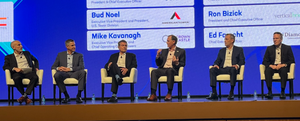BT Boosts US Backbone
The UK carrier is extending its MPLS backbone in the US, but don't expect a monster contract
May 8, 2003

Here's an interesting item: a major European provider is ready to expand its North American network. British Telecommunications plc (BT) (NYSE: BTY; London: BTA) today announced a "new U.S. strategy" that includes extending its Multiprotocol Label Switching (MPLS) backbone (see BT Expands US Backbone).
Don't get too excited. BT says it's only going to invest $7.5 million in expanding its backbone; Cisco Systems Inc. (Nasdaq: CSCO), its regular supplier, will get the bulk of the work.
BT says almost half of its top 2000 target customers are headquartered in the U.S., so a bigger network will enable it to reach more of them. It's adding 14 nodes to its nine-node U.S. network, which it inherited from the breakup of its "Concert" joint venture with AT&T Corp. (NYSE: T) (see AT&T and BT to Unwind JV.
"We're not going to go full-bore into the U.S., as an alternative supplier," says Roger Westbury, a BT spokesman. The goal is to do more deals like the one that BT clinched with Honeywell International Inc. (NYSE: HON) earlier this year (see BT Wins Honeywell Deal).
Under this five-year contract, Honeywell is outsourcing all of its communications for its 220 sites in Western Europe to BT. This includes BT taking over Honeywell's existing Frame Relay and ATM wide area network and migrating to an IP-based VPN. It also includes providing fixed and mobile voice services and video communications, and managing LANs and PBXs within buildings.
BT's ability to support legacy Frame Relay and ATM services comes from implementing Layer 2 VPNs on its IP backbone. Westbury says the majority of traffic on the backbone is data, and "less than 20 percent" is voice. The VOIP quality "might not necessarily be as good" as traditional telephony, he acknowledges.
In Europe, BT's MPLS network extends to more than 1,000 points of presence (POPs) in 70 countries -- figures that make its 23 POPs in the U.S. look a little inadequate. In this respect, it's a long way behind some of its competitors. Equant (NYSE: ENT; Paris: EQU), for instance, has 140 nodes and a partnership with Sprint Corp. (NYSE: FON) that extends its reach even farther. Equant, however, doesn't have quite such a fancy backbone.
BT's biggest competitor in the U.S. is probably its previous partner, AT&T. It has lots of POPs in the U.S. and a similarly designed MPLS backbone, a backbone that corporate customers appear to like (see Multinationals Love AT&T's IP VPNs). AT&T, however, can't match BT's European coverage.
— Peter Heywood, Founding Editor, Light Reading
You May Also Like









